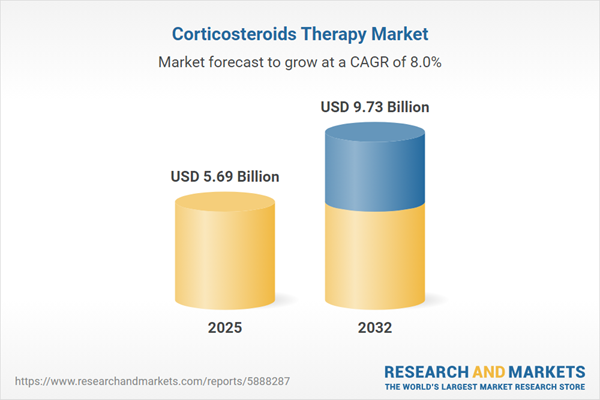Speak directly to the analyst to clarify any post sales queries you may have.
The corticosteroids therapy market is evolving rapidly as new technologies, updated regulatory environments, and a stronger patient focus drive industry transformation. Senior decision-makers require precise market intelligence to ensure their organizations remain both competitive and responsive to ongoing changes.
Market Snapshot: Corticosteroids Therapy Market Size & Growth Outlook
The corticosteroids therapy market continues to advance, with total value rising from USD 5.26 billion in 2024 to USD 5.69 billion in 2025 and projecting to USD 9.73 billion by 2032. This expansion is anchored by a compound annual growth rate (CAGR) of 7.99%. Growth is shaped by evolving regulatory dynamics, enhanced therapeutic technologies, and initiatives tailored to optimize patient care. Leading industry organizations are responding by refining market strategies, extending product offerings, and prioritizing innovations that increase efficiency and align with personalized medicine trends.
Corticosteroids Therapy Market Scope & Segmentation
- Route of Administration: Encompasses a versatile assortment including inhalation devices (dry powder, meter-dosed inhalers, nebulizers), injections (intramuscular, intravenous), oral (tablets, suspensions), and topicals (creams, lotions, ointments). This breadth enables application flexibility across varied clinical and operational environments.
- Indication: Covers an extensive clinical spectrum, addressing allergic rhinitis, asthma, dermatological disorders, inflammatory bowel disease, and rheumatoid arthritis. This wide range of therapeutic applications allows targeted treatment planning and improved positioning in the market.
- Drug Type: Involves both established and new molecules, including budesonide, dexamethasone, hydrocortisone, methylprednisolone, and prednisone. This diversity empowers providers to address multiple disease states efficiently and reliably.
- Dosage Form: Provides options such as creams, injections, suspensions, and tablets, supporting care that meets varying patient needs and healthcare system requirements.
- Patient Age Group: Targets adults, geriatric populations, and pediatric patients. Strategies tailored for each group help providers broaden access to clinical interventions and maintain responsiveness to changing care standards.
- Geography: Spans key markets including the Americas (United States, Canada, Brazil), Europe, the Middle East & Africa, and Asia-Pacific (China, India, Japan). Regional segmentation assists organizations in refining market entry tactics and managing expansion in both mature and growth economies.
- Company Profiles: Highlights major competitors—GlaxoSmithKline plc, AstraZeneca plc, Novartis AG, Sanofi S.A., Merck & Co., Inc., Pfizer Inc., Teva Pharmaceutical Industries Ltd, Sun Pharmaceutical Industries Ltd, Mylan N.V., Sandoz International GmbH—providing a framework for benchmarking and partnership identification.
Corticosteroids Therapy Market: Key Takeaways for Senior Decision-Makers
- Advancements in delivery mechanisms, such as next-generation inhalers and injectables, enhance provider adaptability for acute and long-term therapy, aligning with evolving clinical standards.
- Personalized approaches, including biomarker-guided dosing, are supporting adherence and improved outcomes for chronic as well as episodic therapies where dose consistency matters.
- Integration of digital health tools like real-time patient monitoring and automated support systems is prompting more efficient, data-driven care and enhancing patient participation.
- Changing global regulations place increased emphasis on proactive compliance, requiring robust risk management and supply chain adaptability to avoid delays and ensure product flow.
- Environmental sustainability initiatives are strengthening supply chain resilience, supporting broader organizational goals of cost efficiency and responsible resource management.
Tariff Impact: Navigating Policy Changes and Supply Chain Resilience
Recent tariff changes in the United States are escalating costs across the corticosteroids therapy supply chain. Both raw material costs and final product pricing are affected, prompting manufacturers to revisit sourcing practices and leverage advanced analytics that help reduce impacts to lead times and operational efficiency. In emerging regional markets, companies are adopting agile manufacturing and emphasizing transparent supply chain processes to maintain continuous product availability and build market confidence among stakeholders.
Methodology & Data Sources
Research for this report integrated comprehensive secondary data analysis with primary interviews from clinical and manufacturing experts. Expert validation and triangulation efforts ensure that market insights presented are both reliable and actionable for senior leaders.
Why This Report Matters: Actionable Business Value
- Empowers decision-makers with real-time visibility into how technology, regulatory change, and ongoing innovation are shaping the corticosteroids therapy market globally.
- Enables identification of operational and geographic opportunities for resource optimization and targeted expansion.
- Provides a platform for benchmarking against top industry players, supporting more informed partnership and investment strategies.
Conclusion
This report equips senior executives with targeted, reliable insights on the corticosteroids therapy market, driving proactive and confident decision-making in a complex industry environment.
Additional Product Information:
- Purchase of this report includes 1 year online access with quarterly updates.
- This report can be updated on request. Please contact our Customer Experience team using the Ask a Question widget on our website.
Table of Contents
3. Executive Summary
4. Market Overview
7. Cumulative Impact of Artificial Intelligence 2025
List of Figures
Samples

LOADING...
Companies Mentioned
The key companies profiled in this Corticosteroids Therapy market report include:- GlaxoSmithKline plc
- AstraZeneca plc
- Novartis AG
- Sanofi S.A.
- Merck & Co., Inc.
- Pfizer Inc.
- Teva Pharmaceutical Industries Ltd
- Sun Pharmaceutical Industries Ltd
- Mylan N.V.
- Sandoz International GmbH
Table Information
| Report Attribute | Details |
|---|---|
| No. of Pages | 188 |
| Published | October 2025 |
| Forecast Period | 2025 - 2032 |
| Estimated Market Value ( USD | $ 5.69 Billion |
| Forecasted Market Value ( USD | $ 9.73 Billion |
| Compound Annual Growth Rate | 7.9% |
| Regions Covered | Global |
| No. of Companies Mentioned | 11 |









